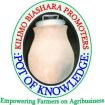Kenya’s agriculture is heavily dependent on rainfall, which has become increasingly unpredictable due to climate change. For farmers in arid and semi-arid regions, growing drought-resistant crops is not just a choice—it’s a necessity. These crops can withstand prolonged dry spells, ensuring food security and income even in harsh conditions. In this article, we’ll explore some of the best drought-resistant crops for Kenyan farmers and share tips on how to grow them successfully.
Why Drought-Resistant Crops Matter
Drought-resistant crops are specially adapted to survive with minimal water. They have deep root systems, waxy leaves, or other features that help them conserve moisture. By planting these crops, farmers can:
- Reduce the risk of crop failure during dry seasons.
- Save water and reduce irrigation costs.
- Maintain food security and income stability.
Top Drought-Resistant Crops for Kenya
- Sorghum
- Why it’s great: Sorghum is a hardy cereal crop that thrives in dry conditions. It’s a staple food in many parts of Kenya and is used to make flour, porridge, and animal feed.
- How to grow: Plant sorghum in well-drained soils with good organic matter. It requires minimal water and can be inter-cropped with legumes like cow-peas.
- Varieties to try: Gadam, Serena, and Sila.
- Millet
- Why it’s great: Millet is another cereal crop that grows well in arid areas. It’s highly nutritious and can be used to make flour, porridge, and traditional beverages.
- How to grow: Millet prefers sandy soils and requires little fertilizer. It matures quickly, making it ideal for short rainy seasons.
- Varieties to try: Pearl millet (KAT/PM1) and finger millet (P224).
- Drought-Tolerant Maize
- Why it’s great: Maize is Kenya’s staple food, and drought-tolerant varieties have been developed to withstand dry conditions.
- How to grow: Plant in well-prepared soils and use mulch to retain moisture. These varieties still need some water, so consider rainwater harvesting.
- Varieties to try: DK8031, WH505, and DH04.
- Cowpeas
- Why it’s great: Cowpeas are a drought-resistant legume that provides protein for families and fodder for livestock.
- How to grow: Cowpeas grow well in poor soils and can be intercropped with cereals like sorghum or maize.
- Varieties to try: M66, K80, and KVU 27-1.
- Cassava
- Why it’s great: Cassava is a root crop that can survive long dry spells. It’s a versatile crop used for food, animal feed, and industrial products.
- How to grow: Cassava grows best in well-drained soils and requires little maintenance. It can be harvested as needed, making it a reliable food source.
- Varieties to try: Tajirika, KME 1, and KME 4.
- Pigeon Peas
- Why it’s great: Pigeon peas are a drought-tolerant legume that improves soil fertility through nitrogen fixation.
- How to grow: Plant in rows with adequate spacing. Pigeon peas can be inter-cropped with cereals or grown as a standalone crop.
- Varieties to try: ICEAP 0057, ICEAP 00040.
Tips for Growing Drought-Resistant Crops
- Soil Preparation: Make sure your soil is well-drained and rich in organic matter. Use compost or manure to improve soil fertility.
- Mulching: Apply mulch to conserve soil moisture and reduce evaporation.
- Rainwater Harvesting: Collect and store rainwater for irrigation during dry spells.
- Crop Rotation: Rotate drought-resistant crops with legumes to improve soil health.
- Early Planting: Plant at the onset of rains to give crops a head start before dry conditions set in.
Success Stories
Many Kenyan farmers have successfully adopted drought-resistant crops. For example, farmers in Kitui County have seen increased yields and income by growing drought-tolerant maize and sorghum. By sharing knowledge and resources, these farmers are building resilience against climate change.
Conclusion
Drought-resistant crops are a lifeline for farmers in Kenya’s arid and semi-arid regions. By choosing the right crops and adopting good farming practices, farmers can overcome the challenges of unpredictable weather and secure their livelihoods. Whether you’re growing sorghum, millet, or cassava, these crops offer hope and opportunity in the face of climate change.



